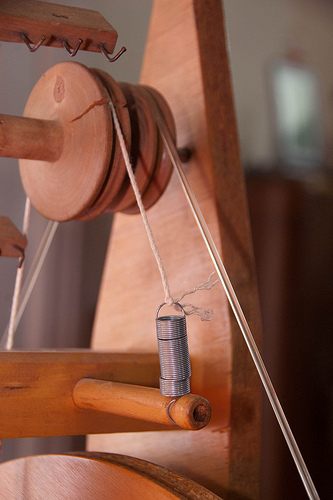
There are two kinds of beginning spinners: those who fear and dislike scotch tension, and those who have wheels without a brake band. Scotch tension is a cryptic mystery, a fickle beast, and it has been the undoing of many a beginning knitter.
When the flyer spins around, the bobbin spins a bit, too. Scotch tension holds the bobbin steady. If you had no tension, the bobbin would get pulled around by the singles and would spin just as fast as the flyer. If the bobbin was held completely steady, the flyer would be wrapping singles around the bobbin so fast that it would rip the fiber right out of your hands.
The challenge is to find the sweet spot where the bobbin is being held back just enough to pull the singles out of your hand smoothly. Not so slack that the singles pile up and you feel like you're pushing them into the orifice. And not so firmly that you're having to play tug-of-war with the wheel.
For me (I have an Ashford Kiwi) this basically amounts to putting just enough tension on the brake band that the little spring stands up, but not so much that the spring is pulled taut at all. I was taught that you should start with zero tension and then gradually - ever so slightly - turn the knob to tighten the brake band until you find the right balance.
Most of the time, the answer is to "loosen the brake band." Except for the situation I faced last night, where even if I had the brake band entirely slack, it was still yanking the fiber out of my fingers. If I removed the brake band entirely, then it was too loose. After struggling with it and trying everything for over an hour, I finally solved this mysterious problem: I wiped off the brake band with rubbing alcohol on a paper towel. I guess somehow it had gotten sticky, although I can't think how.
Scotch tension will be the death of me yet, just you wait and see.
Image courtesy Flickr/punkin3.14

0 comments